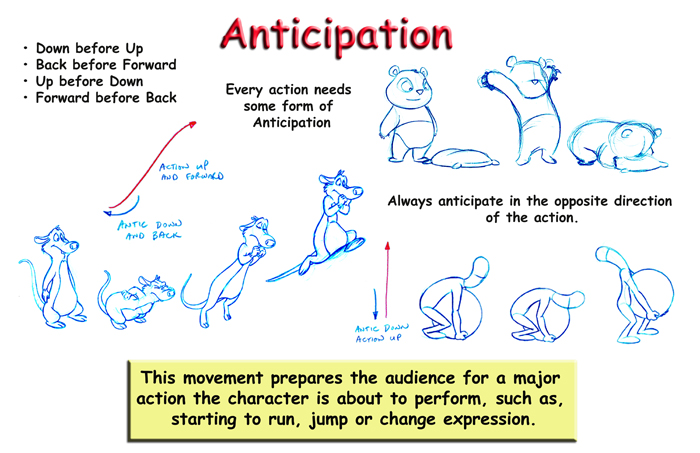
A dancer does not just leap off the floor. A backwards motion occurs before the forward action is executed. The backward motion is the anticipation. A comic effect can be done by not using anticipation after a series of gags that used anticipation. Almost all real action has major or minor anticipation such as a pitcher's wind-up or a golfers' back swing. Feature animation is often less broad than short animation unless a scene requires it to develop a characters personality.
We’ve already discussed a lot about anticipation in the section on stretch and squash. The amount of anticipation required for any action is always proportionate. As a general statement, (not to be held to as an absolute law) let’s say any anticipation should be 10 - 20% the size of the action.
We’ll use the anticipation you need to take before taking a step forward. An average person’s stride is 2 foot lengths. Watch your feet the next time you’re walking someplace. With your left foot on the ground when you swing your right foot forward and place it down, there should be about 1 foot length inbetween them. Therefore the distance from heel to heel is 2 foot lengths.
Now follow along with this part yourself. Go to a place where you can stand next to a wall. Find a specific marker on the wall that you can look at around your eye level. Stand right next to it so you can see it out of the corner of your eye. (The edge of a picture frame is ideal for this.) Now with both feet together take a step forward. Take note of where the marker that you’re using on the wall is in relation to your head as you take the step forward.
You may need to do this a couple of times to notice what happens.
As you raise your one foot to take the step forward you need to counter balance your weight slightly by moving your upper torso back a bit. Some people may anticipate (counter balance) a lot, while others may not do it at all. In fact some people may actually lean into the forward motion of the step, effectively eliminating any anticipation.
If that’s you, let’s try another action... sit down in a chair. Now stand up. Do it again, this time, analyze every action and movement that your body takes to get you up out of the chair.
Most people will go through the following steps in this order:
1) Head and upper torso move forward and down, pivoting at hips
2) Legs shift slightly back
3) head and upper torso move further forward out over knees
4) hands move to position to support and push body up ( to arms of chair and / or knees)
5) Legs, straighten, as pelvis moves forward and up
6) Head and shoulders move up and back, and arms come away from support then straighten
The action of the head and upper torso moving forward and down is the anticipation to the action of standing up. Most of this is all counter balancing.
Some actions may actually require an anticipation to the anticipation, depending on the type of move. If the person is in more of a reclining easy chair, they may need to build up a slight bit of momentum by first moving their head back then into the forward motion before standing up. Larger people need to do this to move their mass forward to the edge of the chair.
Just don’t add too many anticipations. You don’t want to anticipate the anticipation of the anticipation of the anticipation of the anticipation of the anticipation of the movement. This would create too much rocking build up for certain action but could be used for comedic effect in some instances.
A real life, proper use of this would be a character on a swing. The character must build up momentum from a standstill gradually before they can jump off the swing on a forward motion. It would look very strange if a character sat down on a motionless swing then was suddenly going at their full swing without any build up.
Another example of exaggerated anticipation is in the cartoon “Baseball Bugs” where Bugs Bunny does this incredibly convoluted wind-up for his big pitch. This was done for comedic purposes as opposed to the proportionate equivalent.
As was mentioned earlier, anticipation prepares the audience for a major action the character is about to perform, such as, starting to run, jump or change expression. Without anticipation, the action will appear too suddenly and they may miss it or it will catch them off guard. In real life, try to throw a ball without any anticipation and it won’t go nearly as far as with anticipation. Try driving a golf ball without pulling the club back, it becomes a wrist shot.
Anticipation can be as little as 1 drawing in the opposite direction of where you want the object or character to move, of course that would be for a very small action. Usually it’s more like 2 or 3 drawings with a slow-in to the anticipation key.
An anticipation can be treated as a Primary Key or added in later as a Secondary Key depending on how you plan out your animation. You should try to plan it as a Primary Key if possible but if you’re dealing with other things such as secondary action you can leave it to a later Secondary Key. This will be explained in more detail later in some of the assignments.
A very general rule of anticipation is this: go up before going down, go down before going up, go back before going forward, and go forward before going back.